Spatial Homogenization Adjustment and Application of Weather Station Networks in Xinjiang, China
Abstract
1. Introduction
2. Materials and Methods
2.1. Materials
2.1.1. Study Area
2.1.2. Dataset
2.2. Methods
2.2.1. Calculation of Daily, Monthly, and Annual Time-Scale Temperatures for a Single Station at Meteorological Stations
2.2.2. Spatial Homogenization Adjustment of the Xinjiang Weather Data Station Network
- (1)
- value selection
- (2)
- is taken as different areas, corresponding to the coverage in Xinjiang
- (3)
- Station domain area
- (4)
- Station network density
- (5)
- Construction of weighting coefficients for meteorological stations and calculation of spatially homogenized temperature averages
2.2.3. The Equal-weighted Average of the Xinjiang Region Temperature Data
3. Results
3.1. Determination Area
3.2. Station Network Density and Station Domain Area Analysis
3.3. Distribution of Weighting Coefficients of 89 Meteorological Stations in the Xinjiang Region
3.4. Analysis of the Temperature Change Characteristics in Xinjiang
3.4.1. Analysis of the Mean Temperature in Xinjiang
3.4.2. Analysis of the Temperature Change Characteristics in the Xinjiang Region
3.4.3. Analysis of Mutation Temperature in the Xinjiang Region
4. Conclusions and Discussion
Author Contributions
Funding
Institutional Review Board Statement
Informed Consent Statement
Data Availability Statement
Acknowledgments
Conflicts of Interest
Appendix A
| Order Number | Weather Site | Station Domain Area /(20 × 104km2/station) | Station Network Density /(station/20 × 104 km2) | Weight Coefficient |
| 1 | Haba River | 0.07977 | 12.54 | 0.01137 |
| 2 | Jeminay | 0.06241 | 16.02 | 0.008892 |
| 3 | Bulzin | 0.08398 | 11.91 | 0.01197 |
| 4 | Fuhai | 0.08592 | 11.64 | 0.01224 |
| 5 | Altay | 0.07347 | 13.61 | 0.01047 |
| 6 | Fuyun | 0.1012 | 9.880 | 0.01442 |
| 7 | Tacheng | 0.03665 | 27.29 | 0.005221 |
| 8 | Yumin | 0.04270 | 23.42 | 0.006084 |
| 9 | Emin | 0.04384 | 22.81 | 0.006247 |
| 10 | Hobukesar | 0.05825 | 17.17 | 0.008299 |
| 11 | Qinghe | 0.1056 | 9.468 | 0.01505 |
| 12 | Alataw Pass | 0.03403 | 29.38 | 0.004849 |
| 13 | Bole | 0.03018 | 33.14 | 0.004290 |
| 14 | Toli | 0.04038 | 24.77 | 0.005753 |
| 15 | Karamay | 0.05290 | 18.90 | 0.007537 |
| 16 | Baytik Mountain | 0.1228 | 8.142 | 0.01750 |
| 17 | Khorgos | 0.02935 | 34.07 | 0.004182 |
| 18 | Huocheng | 0.03618 | 27.64 | 0.005155 |
| 19 | Wenquan | 0.02563 | 39.02 | 0.003651 |
| 20 | Jinghe | 0.03520 | 28.41 | 0.005015 |
| 21 | Wusu | 0.04469 | 22.38 | 0.006367 |
| 22 | Battery | 0.04484 | 22.30 | 0.006388 |
| 23 | Moso bay | 0.06601 | 15.15 | 0.009406 |
| 24 | Shihezi | 0.04987 | 20.05 | 0.007106 |
| 25 | Shawan | 0.04750 | 21.05 | 0.006767 |
| 26 | Caijiahu | 0.04534 | 22.06 | 0.006460 |
| 27 | Hutubi | 0.04337 | 23.06 | 0.006179 |
| 28 | Jimsar | 0.06077 | 16.45 | 0.008659 |
| 29 | Qitai | 0.06375 | 15.69 | 0.009082 |
| 30 | Qapqal | 0.03916 | 25.54 | 0.005579 |
| 31 | Yining | 0.03792 | 26.37 | 0.005403 |
| 32 | Nilka | 0.03832 | 26.10 | 0.005460 |
| 33 | Yining County | 0.04007 | 24.96 | 0.005709 |
| 34 | Gongliu | 0.04107 | 24.35 | 0.005852 |
| 35 | Xinyuan | 0.04025 | 24.85 | 0.005735 |
| 36 | Zhaosu | 0.03794 | 26.36 | 0.005406 |
| 37 | Takes | 0.04103 | 24.38 | 0.005845 |
| 38 | Urumqi | 0.04337 | 23.06 | 0.006179 |
| 39 | Small canal | 0.04337 | 23.06 | 0.006179 |
| 40 | Balguntay | 0.04534 | 22.06 | 0.006460 |
| 41 | Daxigou | 0.04156 | 24.06 | 0.005921 |
| 42 | Tianchi | 0.04750 | 21.05 | 0.006767 |
| 43 | Dabancheng | 0.04987 | 20.05 | 0.007106 |
| 44 | Mori | 0.07215 | 13.86 | 0.01028 |
| 45 | ümüx | 0.04750 | 21.05 | 0.006767 |
| 46 | Bayanbulak | 0.03836 | 26.07 | 0.005466 |
| 47 | Hejing | 0.04750 | 21.05 | 0.006767 |
| 48 | Yanqi | 0.04987 | 20.05 | 0.007106 |
| 49 | Hoxud | 0.04750 | 21.05 | 0.006767 |
| 50 | Toksun | 0.05250 | 19.05 | 0.007480 |
| 51 | Turpan | 0.05541 | 18.05 | 0.007895 |
| 52 | Shanshan | 0.09067 | 11.03 | 0.01292 |
| 53 | Wushi | 0.09514 | 10.51 | 0.01356 |
| 54 | Aksu | 0.07182 | 13.92 | 0.01023 |
| 55 | Baicheng | 0.05007 | 19.97 | 0.007134 |
| 56 | Xinhe | 0.06988 | 14.31 | 0.009957 |
| 57 | Sanga | 0.09044 | 11.06 | 0.01289 |
| 58 | Luntai | 0.07124 | 14.04 | 0.01015 |
| 59 | Kuqa | 0.07652 | 13.07 | 0.01090 |
| 60 | Yuli | 0.09974 | 10.03 | 0.01421 |
| 61 | Korla | 0.07672 | 13.03 | 0.01093 |
| 62 | torugart | 0.06122 | 16.33 | 0.008723 |
| 63 | Atux | 0.05662 | 17.66 | 0.008067 |
| 64 | Wuqia | 0.05191 | 19.26 | 0.007396 |
| 65 | Jiashi | 0.05753 | 17.38 | 0.008196 |
| 66 | Aktao | 0.06560 | 15.24 | 0.009347 |
| 67 | Aheqi | 0.07020 | 14.25 | 0.01000 |
| 68 | Yopurga | 0.06084 | 16.44 | 0.008668 |
| 69 | Keping | 0.09802 | 10.20 | 0.01397 |
| 70 | Awat | 0.09841 | 10.16 | 0.01402 |
| 71 | Alar | 0.09539 | 10.48 | 0.01359 |
| 72 | Tikanlilk | 0.1247 | 8.021 | 0.01776 |
| 73 | Ruoqiang | 0.3264 | 3.064 | 0.04650 |
| 74 | Yingjisha | 0.06563 | 15.24 | 0.009351 |
| 75 | Tashkurgan | 0.05708 | 17.52 | 0.008133 |
| 76 | Shache | 0.08703 | 11.49 | 0.01240 |
| 77 | Yecheng | 0.08581 | 11.65 | 0.01223 |
| 78 | Zepu | 0.08619 | 11.60 | 0.01228 |
| 79 | Pishan | 0.1101 | 9.085 | 0.01568 |
| 80 | Cele | 0.1857 | 5.386 | 0.02645 |
| 81 | Hotan | 0.1622 | 6.165 | 0.02311 |
| 82 | Minfeng | 0.2274 | 4.397 | 0.03240 |
| 83 | Qiemo | 0.4945 | 2.022 | 0.07045 |
| 84 | Yutian | 0.2197 | 4.552 | 0.03130 |
| 85 | Barkol | 0.1340 | 7.461 | 0.01910 |
| 86 | Nom | 0.09446 | 10.59 | 0.01346 |
| 87 | Yiwu | 0.1162 | 8.605 | 0.01656 |
| 88 | Hami | 0.1657 | 6.035 | 0.02361 |
| 89 | Red willow river | 0.1237 | 8.081 | 0.01763 |
References
- Masson-Delmotte, V.; Zhai, P.; Pirani, A.; Connors, S.L.; Péan, C.; Berger, S.; Caud, N.; Chen, Y.; Goldfarb, L.; Gomis, M.I.; et al. Summary for Policy-makers. In Climate Change 2021: The Physical Science Basis. Contribution of Working Group I to the Sixth Assessment Report of the Intergovernmental Panel on Climate Change; Cambridge University Press: Cambridge, MA, USA, 2021. [Google Scholar]
- CMA. CMA 2022: China Climate Bulletin 2017. China Meteorological Administration. Available online: www.cma.gov.cn/root7/auto13139/201801/t20180117_460484.html (accessed on 10 August 2021).
- XCC. Xinjiang Climate Change Monitoring Bulletin; Xinjiang Climate Center: Xinjiang, China, 2022. [Google Scholar]
- Luo, X. Study on Station Network Homogeneity Adjustment for Climate Data of China and Its Application; Nanjing Information Engineering University: Nanjing, China, 2011. [Google Scholar]
- Ma, P.L.; Yang, J.H.; Lu, G.Y.; Zhu, B.; Liu, W. The Transitional Change of Climate in the East of Northwest China. Plateau Meteorol. 2020, 39, 840–850. [Google Scholar] [CrossRef]
- Gubler, S.; Hunziker, S.; Begert, M.; Croci-Maspoli, M.; Konzelmann, T.; Brönnimann, S.; Schwierz, C.; Oria, C.; Rosas, G. The influence of station density on climate data homogenization. Int. J. Climatol. 2017, 37, 4670–4683. [Google Scholar] [CrossRef]
- Jones, P.D.; Wigley, T.M.L. Estimation of global temperature trends: What’s important and what isn’t. Clim. Change 2010, 100, 59–69. [Google Scholar] [CrossRef]
- Trewin, B.C.; Trevitt, A.C.F. The development of composite temperature records. Int. Climatol. 1996, 16, 1227–1242. [Google Scholar] [CrossRef]
- Della-Marta, P.M.; Wanner, H. A method of homogenizing the extremes and mean of daily temperature measurements. J. Clim. 2006, 19, 4179–4197. [Google Scholar] [CrossRef]
- Vincent, L.A.; Wang, X.L.; Milewska, E.J.; Wan, H.; Feng, Y.; Swail, V. A second generation of homogenized Canadian monthly surface air temperature for climate trend analysis. J. Geophys. Res. 2012, 117, D18110. [Google Scholar] [CrossRef]
- Trewin, B.C. A daily homogenized temperature data set for Australia. Int. J. Climatol. 2013, 33, 1510–1529. [Google Scholar] [CrossRef]
- Cao, L.; Zhu, Y.; Tang, G.; Yuan, F.; Yan, Z. Climatic warming in China according to a homogenized data set from 2419 stations. Int. J. Climatol. 2016, 36, 4384–4392. [Google Scholar] [CrossRef]
- Wang, X.L.; Feng, Y. RHtestsV3 User Manual. Climate Research Division, Atmospheric Science and Technology Directorate, Science and Technology Branch; Environment Canada: Toronto, ON, Canada, 2010. [Google Scholar]
- Dong, S.; Sun, Y.; Aguilar, E.; Zhang, X.; Peterson, T.C.; Song, L.; Zhang, Y. Observed changes in temperature extremes over Asia and their attribution. Clim. Dyn. 2018, 51, 339–353. [Google Scholar] [CrossRef]
- Hu, T.; Sun, Y. Anthropogenic influence on extreme temperatures in China based on CMIP6 models. Int. J. Climatol. 2022, 42, 2981–2995. [Google Scholar] [CrossRef]
- Wang, Y.; Sun, Y.; Hu, T.; Qin, D.; Song, L. Attribution of temperature changes in Western China. Int. J. Climatol. 2018, 38, 742–750. [Google Scholar] [CrossRef]
- Jones, P.D.; Hulme, M. Calculating regional climatic time series for temperature and precipitation: Methods and illustrations. Int. J. Climatol. 1996, 16, 361–377. [Google Scholar] [CrossRef]
- Chung, C.; Nigam, S. The weighting of geophysical data in Principal Component Analysis. J. Geophys. Res. 1999, 104, 16925–16928. [Google Scholar] [CrossRef]
- Zhu, C. A diagnostic method of the air temperature change trending in China. Q. J. Appl. Meteorol. 1992, S1, 114–118. [Google Scholar]
- Wang, P.; Luo, X.; Li, L.; Zhou, G.; Xie, Y. A scheme and its application of network homogeneity adjustment for climatic data of China. Trans. Atmos. Sci. 2011, 34, 8–13. [Google Scholar]
- Wang, Q.; Zhai, P.M.; Qin, D.H. New perspectives on ‘warming-wetting’ trend in Xinjiang, China. Adv. Clim. Change Res. 2020, 11, 252–260. [Google Scholar] [CrossRef]
- Yao, J.; Chen, Y.; Guan, X.; Zhao, Y.; Chen, J.; Mao, W. Recent climate and hydrological changes in a mountain–basin system in Xinjiang, China. Earth-Sci. Rev. 2022, 226, 103957. [Google Scholar] [CrossRef]
- Wu, Z.; Zhang, H.; Krause, C.M.; Cobb, N.S. Climate change and human activities: A case study in Xinjiang, China. Clim. Change 2010, 99, 457–472. [Google Scholar] [CrossRef]
- Kang, L.; Batur, B.; Luo, N.; Xue, Y.; Wang, M. Spatial-temporal Variations of Temperature and Precipitation in Xinjiang from 1961 to 2013. Xinjiang Agric. Sci. 2018, 55, 123–133. [Google Scholar] [CrossRef]
- Zhang, Y.; Chu, X.; Yang, S.; Guo, C. Climate Change in North Xinjiang in Recent 56 Years. Arid. Zone Res. 2019, 36, 212–219. [Google Scholar] [CrossRef]
- Zhang, Y.; Tuerxunbai, G.; Su, L.; Li, Q. Spatial and temporal characteristics of climate change at different altitudes in Xinjiang in the past 60 years. Arid. Land Geogr. 2019, 42, 822–829. [Google Scholar] [CrossRef]
- Li, P.; Lin, J.; Maidi, K. Effects of future climate change on potential geographic distribution of Calliptamus italics (L.) in Xinjiang. Plant Prot. 2017, 43, 90–96. [Google Scholar] [CrossRef]
- Li, Z.; Cheng, Z.; Zhang, L.; Lu, B. Variation characteristics and prediction of hydrological factors in Xinjiang under the influence of climate changes. Water Sci. Eng. Technol. 2018, 6, 1–6. [Google Scholar]
- Zhao, L.; Li, W.; Umiti, G.; Lv, N. Effects of climate change on cotton planting layout and growth in Xinjiang. Xinjiang Farm Res. Sci. Technol. 2018, 41, 7–10. [Google Scholar]
- Zhang, S.; Pu, Z.; Li, X.; Ji, C. Impact of climate change on apple-planting climatic suitability in Xinjiang. Chin. J. Agric. Resour. Reg. Plan. 2018, 39, 255–264. [Google Scholar] [CrossRef]
- Chang, H.; Liu, W. Dynamic Effect Analysis of Meteorological Disasters on Agricultural Economy in Xinjiang Production and Construction Corps under the Background of Climate Change. Ecol. Econ. 2019, 35, 125–129. [Google Scholar]
- Guo, C.; Chu, X.; Zhang, Y.; Luan, Y.; Xu, C. Climate Change and Response to Drought and Flood Disasters in Northern Xinjiang. Southwest China J. Agric. Sci. 2019, 32, 929–935. [Google Scholar] [CrossRef]
- Zhao, P.; Chen, T.; Wang, Q.; Ruide, Y.U. Quantitative analysis of the impact of climate change and human activities on grassland ecosystem NPP in Xinjiang. J. Univ. Chin. Acad. Sci. 2020, 37, 51–62. [Google Scholar] [CrossRef]
- Zhou, G.; Wang, P.; Luo, X.; Xie, Y. Characteristics of Surface Air Temperature Anomalies in China Based on Observations at 160 Stations. J. Appl. Meteorol. Sci. 2011, 22, 283–291. [Google Scholar]
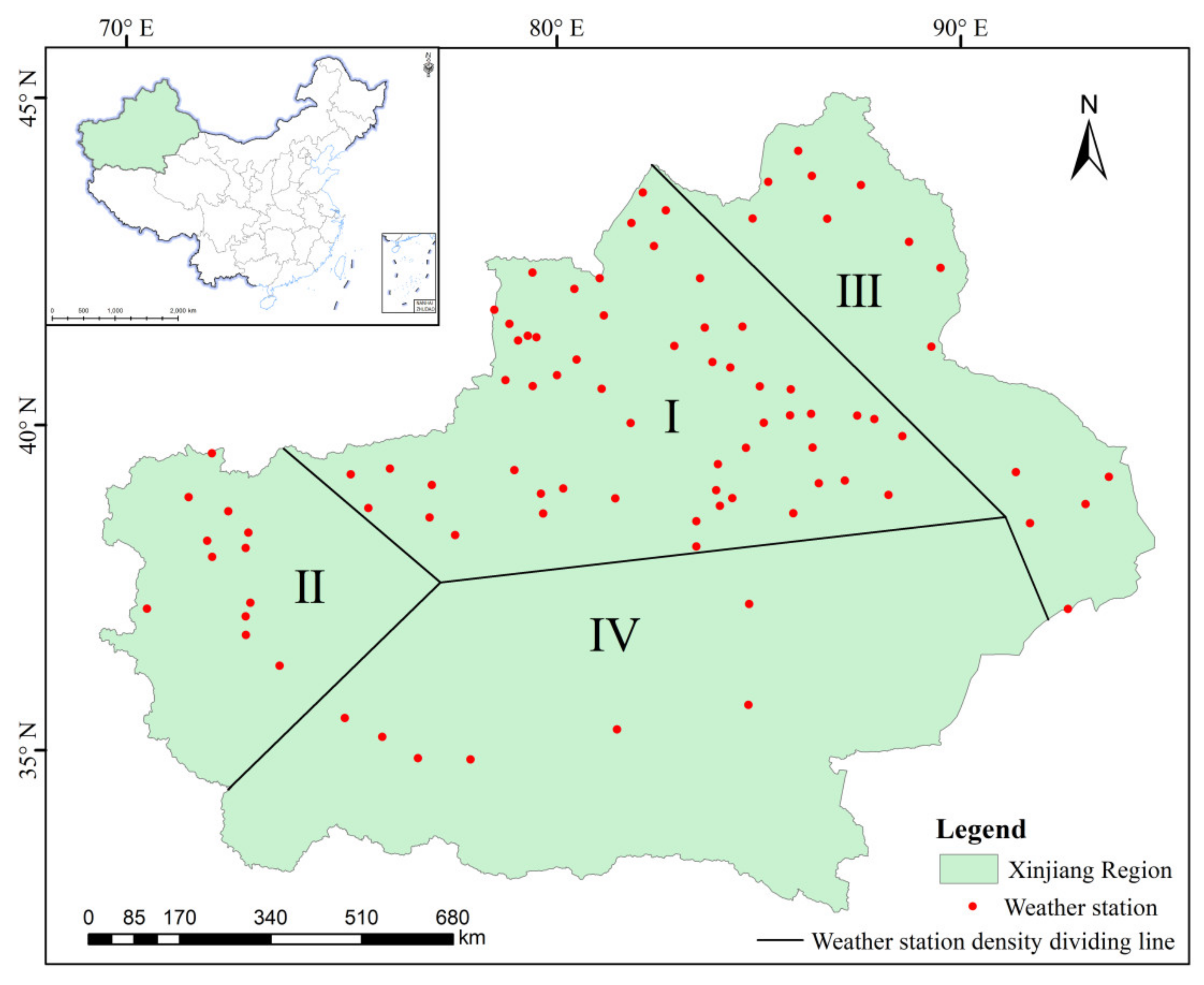
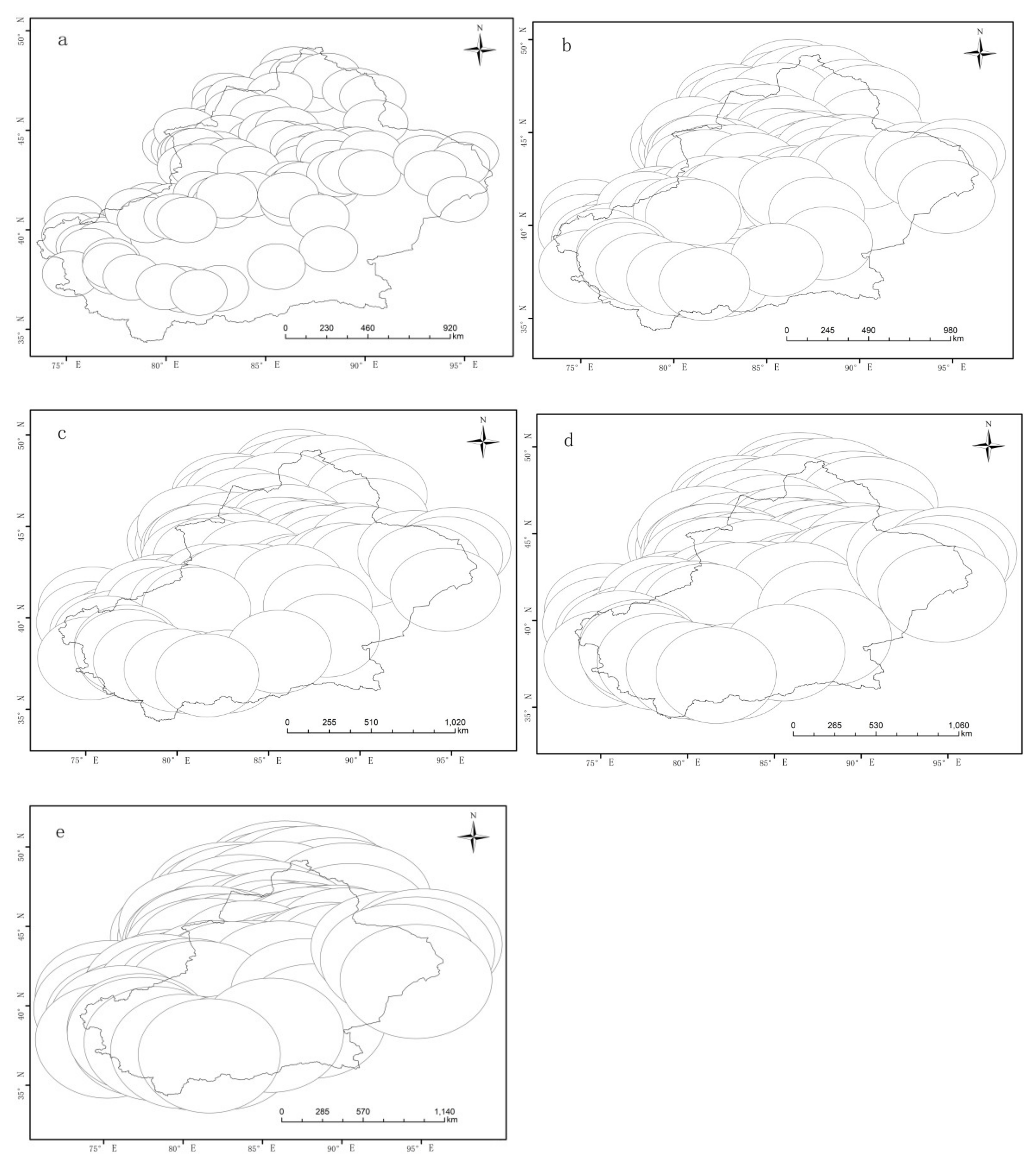
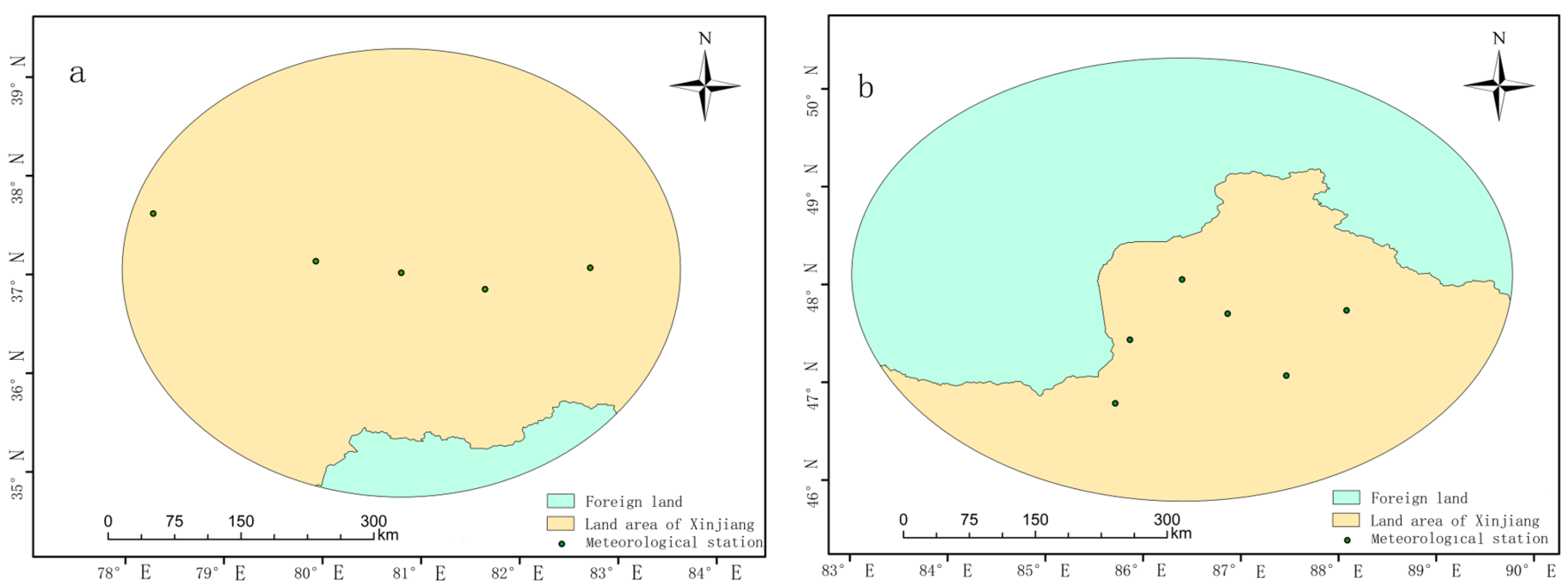

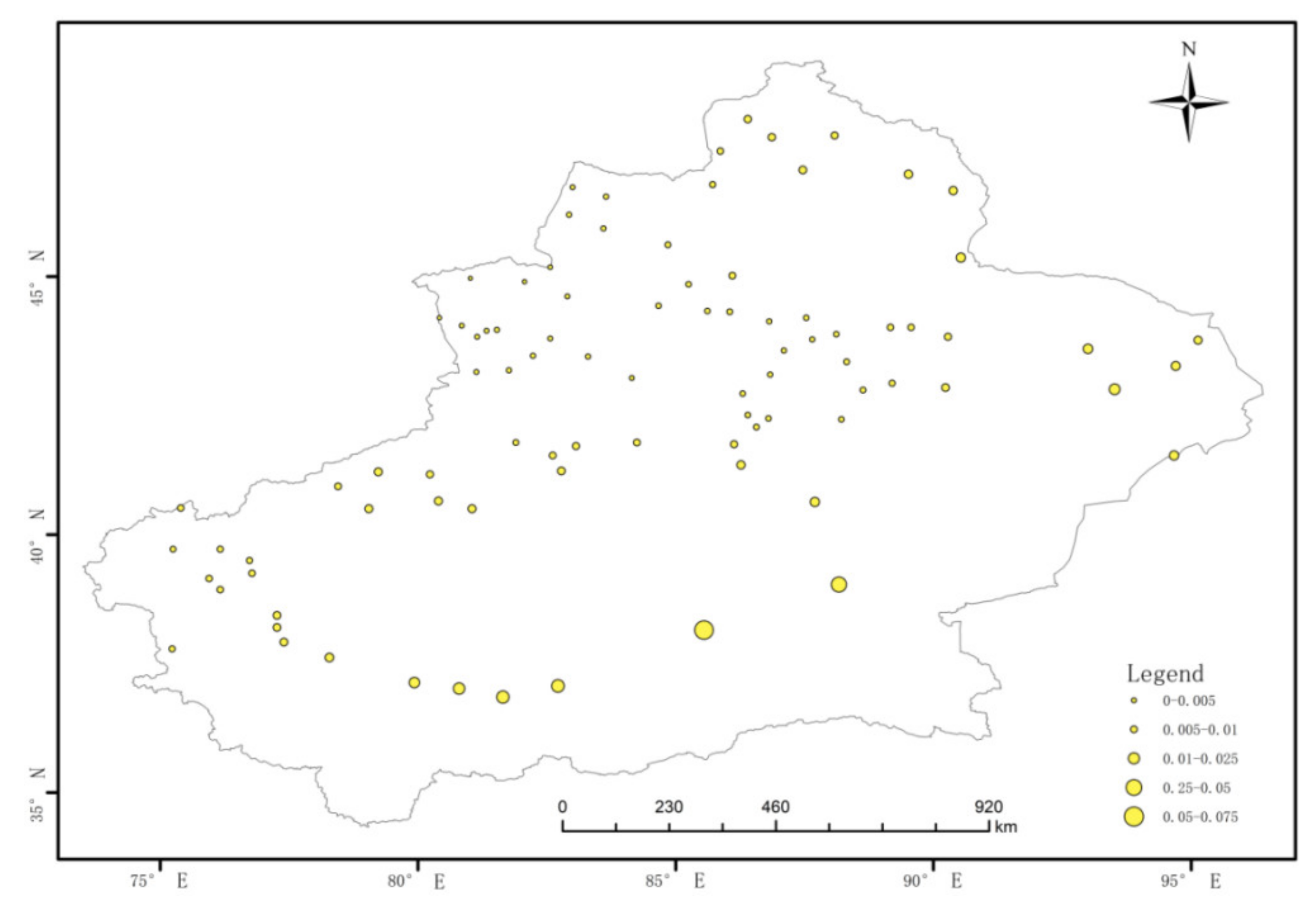


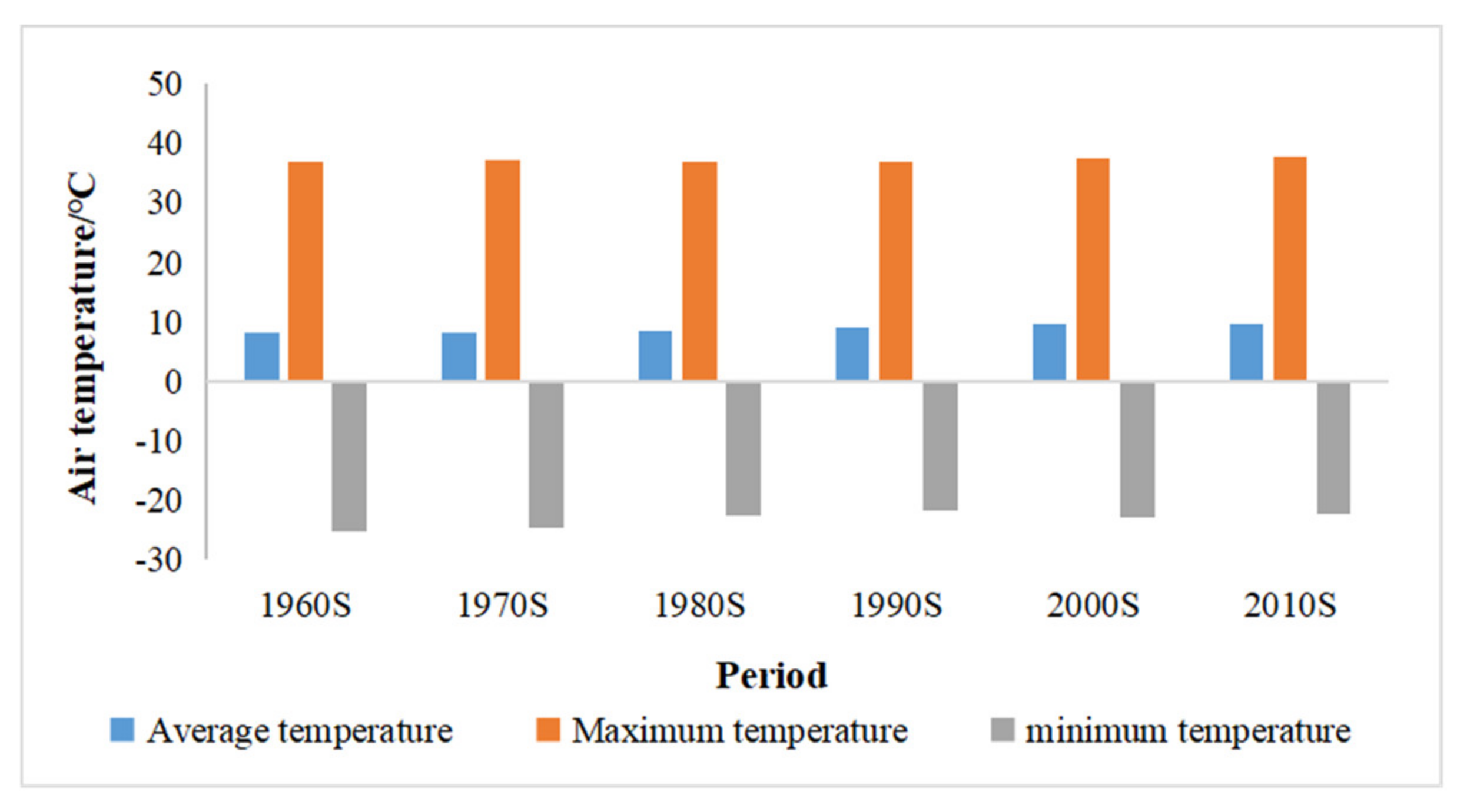

| 10 × 104 | 15 × 104 | 20 × 104 | 30 × 104 | 50 × 104 | |
|---|---|---|---|---|---|
| Coverage/% | 73.0 | 92.9 | 96.0 | 99.0 | 99.9 |
Publisher’s Note: MDPI stays neutral with regard to jurisdictional claims in published maps and institutional affiliations. |
© 2022 by the authors. Licensee MDPI, Basel, Switzerland. This article is an open access article distributed under the terms and conditions of the Creative Commons Attribution (CC BY) license (https://creativecommons.org/licenses/by/4.0/).
Share and Cite
Zhang, L.; Si, J.; Jiapaer, G.; Zhang, T.; Mao, W.; Dong, S. Spatial Homogenization Adjustment and Application of Weather Station Networks in Xinjiang, China. Atmosphere 2022, 13, 1840. https://doi.org/10.3390/atmos13111840
Zhang L, Si J, Jiapaer G, Zhang T, Mao W, Dong S. Spatial Homogenization Adjustment and Application of Weather Station Networks in Xinjiang, China. Atmosphere. 2022; 13(11):1840. https://doi.org/10.3390/atmos13111840
Chicago/Turabian StyleZhang, Liancheng, Jiayi Si, Guli Jiapaer, Taixi Zhang, Weiyi Mao, and Siyan Dong. 2022. "Spatial Homogenization Adjustment and Application of Weather Station Networks in Xinjiang, China" Atmosphere 13, no. 11: 1840. https://doi.org/10.3390/atmos13111840
APA StyleZhang, L., Si, J., Jiapaer, G., Zhang, T., Mao, W., & Dong, S. (2022). Spatial Homogenization Adjustment and Application of Weather Station Networks in Xinjiang, China. Atmosphere, 13(11), 1840. https://doi.org/10.3390/atmos13111840








